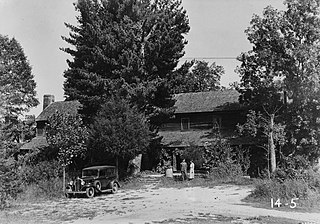
Travelers Rest State Historic Site is a state-run historic site near Toccoa, Georgia. Its centerpiece is Traveler's Rest, an early tavern and inn. It was designated a National Historic Landmark on January 29, 1964, for its architecture as a well-preserved 19th-century tavern, and for its role in the early settlement of northeastern Georgia by European Americans.
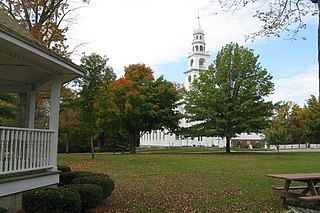
The Templeton Common Historic District encompasses the historic town center of Templeton, Massachusetts. Laid out in the 1750s, the area has been the focus of the town's civic and economic affairs since, and includes its finest assortment of 18th and early 19th-century architecture. The district was added to the National Register of Historic Places in 1983. The district was in 2010 named as one of the 1,000 places to visit in Massachusetts by the Great Places in Massachusetts Commission.

The Golden Ball Tavern is a historic tavern, now a museum, located in Weston, Massachusetts. Built in 1768, it is one of the town's finest examples of Late Georgian architecture. It also played a pivotal role in local activities during the American Revolution, due to its Loyalist tavern keeper. The tavern was listed on the National Register of Historic Places in 1972, and was included in Weston's Boston Post Road Historic District in 1983.
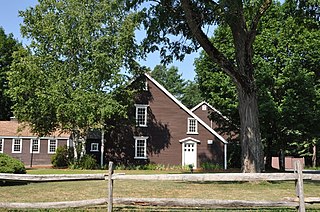
The Manning Manse is a historic house at 56 Chelmsford Road in North Billerica, Massachusetts. Built about 1696, it is one of the oldest surviving buildings in Billerica. It has further associations with local and nationally prominent members of the Manning family, and is a significant early example of historic preservation in the United States. Since the mid-20th century it has typically housed a restaurant, under lease from a family association. It was listed on the National Register of Historic Places in 1982.

Hoar Tavern, or the Hoar Homestead, is a historic tavern and house northeast of downtown Lincoln on Reiling Pond Road in Lincoln, Massachusetts. With a construction history dating to 1680, it was for nearly two centuries home to the Hoar family, a prominent legal and political family in Massachusetts. It was listed on the National Register of Historic Places in 1973.

The Jerry Nichols Tavern is a historic house in Reading, Massachusetts. It is a 2+1⁄2-storey wood-frame structure, five bays wide, with a side gable roof, central chimney, and clapboard siding. The main entrance is flanked by pilasters and topped by an entablature. The oldest portion of the house was built in 1785 by Jeremiah Nichols, a Revolutionary War veteran, farmer, and shoemaker. This property was where Reading's minute companies drilled prior to the American Revolutionary War, and where its powder magazine was kept. The building was expanded 1810–13, and had by 1830 been adapted as a tavern and stage coach stop. In 1824 it was bought by Rev. Peter Sanborn, in whose family it remained into the 1940s.

The Walker Tavern is a historic structure located at 11710 U.S. Route 12 in Cambridge Township in northwesternmost Lenawee County, Michigan. It was designated as a Michigan Historic Site on February 19, 1958, and was later the county's first property added to the National Register of Historic Places on January 25, 1971. The structure was incorporated into the Cambridge Junction Historic State Park and continues to serve as a museum and venue for various events.

Hill's Tavern is a historic building in Scenery Hill, Pennsylvania. It was heavily damaged by a fire that started shortly before midnight on August 17, 2015. For a period in the early 1900s, the inn was known as Central Hotel. Now called the Century Inn, it has been claimed to have been the oldest tavern in continuous use on the National Road, until the fire brought an end to its 221 years of continuous operation.

The Wilder Homestead is located on Ashfield Road, 0.25 miles (0.40 km) south of the Upper Road/Ashfield Road junction, in Buckland, Massachusetts. The property includes three buildings, two of which contribute to its significance. The house was built c. 1775, and is a fairly typical Georgian colonial two story house, in which the rear roof extends down to the first floor in saltbox fashion. A 19th century ell extends from the east side of the house. The house was built for Gardner Wilder, who had recently moved to the area, and had purchased 200 acres (81 ha) to farm.
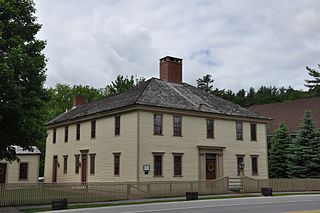
The Stanley Tavern is a historic tavern building at 371 Main Street in Hopkinton, New Hampshire, United States. The oldest portion of this Georgian wood-frame structure was built c. 1791 by Theophilus Stanley, to serve as a tavern in the town, which was at the time vying with Concord to be the state capital. It is the only surviving tavern of three that were known to be present in the town in the late 18th and early 19th century. The building was listed on the National Register of Historic Places in 2005, and the New Hampshire State Register of Historic Places in 2002.
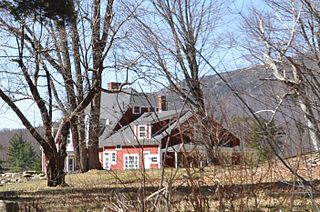
Corey Farm, also known as Maplecote and Interbrook, is a historic farmstead and summer house on Parsons Road in Dublin, New Hampshire. Built about 1816 and enlarged later in the 19th century, it is a picturesque example of the adaptation of an older farm property for use as a summer estate. The house was listed on the National Register of Historic Places in 1983.

The Frost Farm is a historic farmstead at 18 Fairwood Drive in Dublin, New Hampshire, United States. Built in 1855 and extensively restyled in 1910, it is a good example of a Georgian Revival summer house, with expansive views of nearby Mount Monadnock. The property was listed on the National Register of Historic Places in 1983. It is now home to the Fairwood Bible Institute.
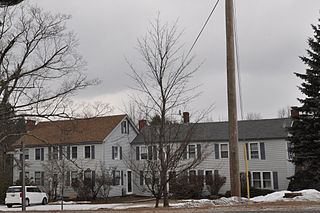
The Isaac Greenwood House is a historic house on New Hampshire Route 101 in eastern Dublin, New Hampshire, United States. The oldest portion of this house was built c. 1784 by Isaac Greenwood, a veteran of the American Revolutionary War. The house, a good example of additive architecture of the 19th century, was listed on the National Register of Historic Places in 1983.

The Moses Greenwood House, formerly the Dublin Inn, is a historic house at the corner of Pierce Road and Old County Road in Dublin, New Hampshire, United States. Built about 1783, it was substantially enlarged and converted into an inn in the early 20th century. The inn was the site of a meeting of notable Americans in 1945, who drafted the Dublin Declaration. The house was listed on the National Register of Historic Places in 1983.

The Benjamin Marshall House is a historic house at 1541 Peterborough Road in Dublin, New Hampshire. Built sometime between 1821 and 1833, it is a well-preserved example of a vernacular Greek Revival farmhouse. It was listed on the National Register of Historic Places in 1983.

The Rufus Piper Homestead is a historic house on Pierce Road in Dublin, New Hampshire. The house is a well-preserved typical New England multi-section farmhouse, joining a main house block to a barn. The oldest portion of the house is one of the 1+1⁄2-story ells, a Cape style house which was built c. 1817 by Rufus Piper, who was active in town affairs for many years. The house was listed on the National Register of Historic Places in 1983. The home of Rufus Piper's father, the Solomon Piper Farm, also still stands and is also listed on the National Register of Historic Places.

The Townsend Farm is a historic farmstead on East Harrisville Road in Dublin, New Hampshire. Built about 1780 and enlarged about 1850 and again at the turn of the 20th century, it is one of Dublin's older houses, notable as the home and studio of artist George DeForest Brush, one of the leading figures of Dublin's early 20th-century art colony. The house was listed on the National Register of Historic Places in 1983.

The Willard Homestead is a historic house on Sunset Hill Road in Harrisville, New Hampshire. Built about 1787 and enlarged several times, it is notable as representing both the town's early settlement history, and its summer resort period of the early 20th century. The house was listed on the National Register of Historic Places in 1988.

The Locust Creek House Complex is a historic former tavern turned farmstead at 4 Creek Road in Bethel, Vermont. Built in 1837 and enlarged in 1860, it is a rare surviving example of a rural tavern in the state, with an added complex of agriculture-related outbuildings following its transition to a new role. The property was listed on the National Register of Historic Places in 1982. It now houses residences.

Reeves Tavern is a historic colonial tavern in Wayland, Massachusetts. Built in 1762–63, it is one of the town's best preserved examples of an early tavern. It was listed on the National Register of Historic Places in 2016.





















